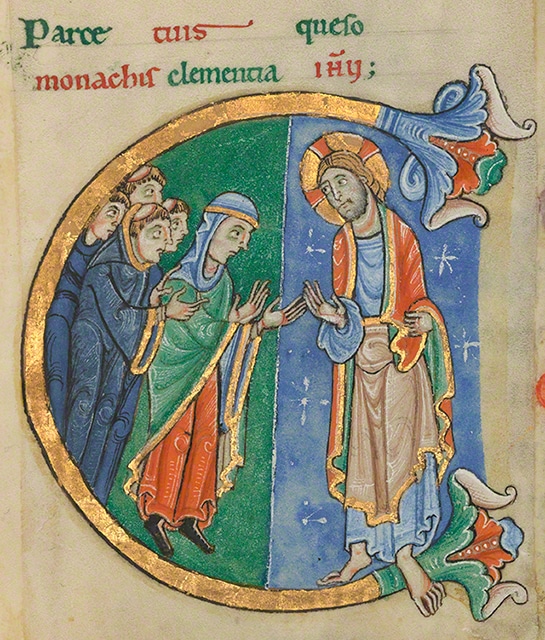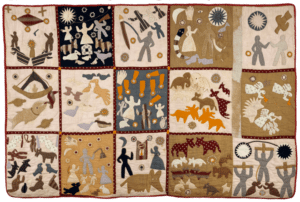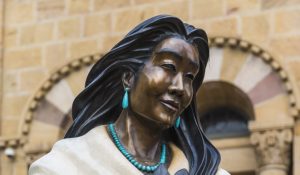In medieval Europe, the theology and practice of Christian mysticism flourished. Mystics were those who tried to identify or pursue communion with God by meditation, visions, intuition and insight. These four women were unusual in their religious influence at a time when women were thought to be physically, mentally, and spiritually weaker than men.
Christina of Markyate

Born in 1096 in England to a noble family, Christina had a religious experience at an early age. Her parents took her to the monastery of Saint Alban where she was moved by the monastic life she saw there. She immediately took a vow of virginity and surrendered her life to God.
Her parents ignored her vow and tried to arrange a marriage to a noble of appropriate standing. When she refused, they tried to force her to agree by shutting her away, abusing her, and bribing other girls to convince her to marry.
When her parents tried to trap her in a room alone with her intended husband, she finally ran away to live as a recluse at Markyate. She became widely known for her holiness and visions, and a monk was inspired to record her life story. She formally took vows as a nun in 1130.
Hildegard of Bingen

Hildegard of Bingen was given by her parents as a tithe to God to her relative Jutta, abbess of a Benedictine convent. She took vows herself when she was 15, and became the abbess when Jutta died.
From her childhood Hildegard had visions, seeing objects and people glowing with light, along with debilitating migraines. She wrote about her visions in her first book, “Scivias”. She was also a prolific composer of music for the convent, and wrote books about natural science called “Physica” and “Causae et Curae”. Pope Eugenius III became her patron and urged her to publish more writings.
Saint Clare of Assisi

Clare of Assisi was born to a wealthy noble family and noted for her beauty. Her father arranged a marriage for her by the time she was 15, but after hearing Saint Francis preach she was captivated and decided to run away. With the help of Saint Francis, she ran to a Benedictine convent, cutting off her long hair.
She went to live at San Damiano and eventually became the abbess there. Clare wanted to be able to travel and care for the sick and poor like an itinerant friar, but it wasn’t socially acceptable for nuns to do this at the time. Instead, she had to live a life of enclosure at the convent.
Near the end of her life, she wrote a monastic rule for the convent giving practical rules for how the nuns should live together and support and govern themselves. This is the first known monastic Rule written by a woman, and is notable for adopting a non-hierarchical structure for ruling the convent. She also left out the practice on enclosure, instead writing that women should be able to leave the convent if for “some useful, reasonable, evident, and approved purpose”. The day before she died she received a bull from Pope Innocent IV accepting her Rule in its entirety.
Margery Kempe
Margery Kempe was born in 1373 in Norfolk, England. She was the daughter of the mayor and owned a profitable brewing business.
Married at the age of 20, she had a very difficult pregnancy and suffered from postpartum psychosis. For about six months after the birth of her first child, she heard voices and had visions of damnation. She was convinced that she had committed a grave sin early in her life that she had to atone for. At the end of her ordeal, she saw a vision of Christ sitting on the edge of her bed, which immediately restored her sanity.
When her brewing business collapsed soon after, she devoted her life to her religion. She wanted to live a life of chastity, but her husband wouldn’t let her and she went on to have 14 children.
Later in life, Margery traveled around Britain and even to Assisi, Rome, Germany, and the Holy Lands to talk to famous religious figures, sharing her views and debating beliefs with them. She became famous for her visions and her ability to see into the future.
Medieval women mystics took great personal risk in coming forward with their visions and religious ideas. Many were persecuted and some even burned at the stake for their beliefs. Still, these women felt compelled to share their religious ideas and understandings, and their writings are some of the early writings by women that survive to this day.
Keri is a blogger and digital marketing professional who founded Amazing Women In History in 2011.






Leave a Reply